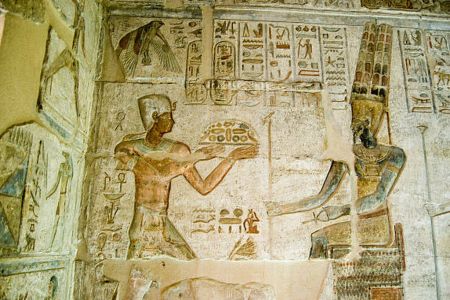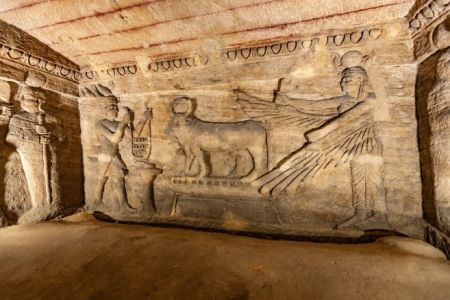the Serapeum of Alexandria

The Majestic Serapeum of Alexandria: A Lost Wonder of Ancient Egypt
The Serapeum of Alexandria once stood as one of the most awe-inspiring religious and cultural centers in the ancient world. Nestled in the vibrant heart of Alexandria City, this temple wasn’t merely a shrine—it was a beacon of blended faith, intellectual pursuit, and architectural brilliance. Dedicated to the Greco-Egyptian god Serapis, the Serapeum symbolized the fusion of Greek and Egyptian traditions, reflecting the cosmopolitan identity of the Ptolemaic era. Its grandeur rivaled any monument in Egypt, even those along The Nile River, and its influence echoed through centuries of philosophy, religion, and art.
From the moment visitors climbed its sacred steps, the Serapeum of Alexandria commanded reverence. Towering columns, intricate sculptures, and the renowned ‘Daughter Library’—a branch of the Library of Alexandria—made the site a hub for scholars and pilgrims alike. It wasn’t merely a temple; it was a sanctuary of divine contemplation and scholarly dialogue. The Serapeum’s tragic destruction marked more than the loss of a building—it symbolized the fading of an era where reason and religion coexisted harmoniously. Today, though only remnants remain, its legacy continues to spark curiosity among historians, travelers, and spiritual seekers exploring Egypt’s ancient mysteries.
Origins of the Serapeum: Birth of a Divine Fusion
The Serapeum of Alexandria emerged under the Ptolemaic dynasty, around the 3rd century BCE, as part of a grand effort to unify Greek and Egyptian cultures. Ptolemy I Soter, one of Alexander the Great’s generals, commissioned the creation of the god Serapis—a deity merging Osiris and Apis from Egyptian tradition with Hellenic traits resembling Zeus and Hades. This innovative syncretism was more than symbolic; it was political genius. The Serapeum embodied this union, providing a shared spiritual foundation for Egyptian priests and Greek settlers alike. The temple became a physical and ideological bridge between two worlds, encapsulating the vibrant spirit of Hellenistic Alexandria.
Architectural Splendor of the Serapeum Complex
The Serapeum’s architecture mirrored the majesty of both Egyptian and Greek design philosophies. Built upon a raised platform on Alexandria’s southwestern hill, the temple was accessible via grand stairways flanked by sphinxes and sculptures. Colossal pillars, possibly inspired by classical Greek orders, surrounded a central sanctuary housing Serapis’ statue. Reports from ancient travelers describe the statue as monumental, carved from the finest materials, and adorned with sacred symbols. Surrounding courtyards, shrines, and lecture halls suggested that the Serapeum wasn’t just a holy site but also a center for learning—an extension of the intellectual might of Alexandria Bibliotheca.
The Role of Serapis: God of Healing, Resurrection, and Knowledge
Serapis symbolized the unification of life and afterlife, intellect and faith. To the Greeks, he resembled a wise and benevolent Zeus-like figure, while to Egyptians, he was the manifestation of Osiris resurrected as Apis. Worshippers turned to him for healing, wisdom, and fertility. His cult spread rapidly across the Mediterranean, from Egypt to Rome, transforming the Serapeum of Alexandria into a spiritual headquarters. Priests of Serapis conducted rituals that blended chants in Greek and hieroglyphic inscriptions, reflecting the seamless fusion of two civilizations. The Serapeum thus became not only a temple but a symbol of universal spirituality transcending borders and language.
The Daughter Library: Alexandria’s Second House of Knowledge
Within the Serapeum complex stood the fabled Daughter Library, an annex of the great Library of Alexandria. This repository safeguarded countless scrolls covering philosophy, astronomy, mathematics, and medicine. Scholars who couldn’t access the main library often studied here, making the Serapeum a secondary center of enlightenment. Historians suggest that after the primary library’s partial destruction, the Daughter Library preserved much of Alexandria’s intellectual legacy. Its destruction later on marked a pivotal moment in the decline of ancient knowledge, symbolizing humanity’s eternal struggle between enlightenment and fanaticism.
The Destruction of the Serapeum: Clash of Faiths and Empires
The demise of the Serapeum of Alexandria remains a poignant chapter in history. By the 4th century CE, as Christianity gained dominance in Egypt, the temple became a target of ideological conflict. Emperor Theodosius I’s decree against pagan worship in 391 CE sealed its fate. Christian zealots stormed the complex, demolishing statues and burning sacred texts. This act wasn’t merely a physical assault but a symbolic victory for a new faith over the old pantheon. What once represented unity and wisdom became a casualty of intolerance—a sobering reminder of how political and religious upheavals can erase centuries of cultural harmony.
Archaeological Discoveries and Rediscovery
Modern excavations at the Serapeum site have unearthed fragments that whisper of its ancient glory. The most iconic surviving artifact is the ‘Pompey’s Pillar,’ a towering Roman granite column that once adorned the Serapeum courtyard. Contrary to popular belief, it has no relation to Pompey but commemorates Emperor Diocletian’s victory. Surrounding ruins reveal traces of underground chambers and tunnels, possibly linked to sacred rituals. Archaeologists have also uncovered remnants of statues and inscriptions, offering glimpses into the temple’s lost splendor. Visiting today, one can still sense the echoes of chants that once filled its revered halls.
Symbolism in Art and Sculpture of the Serapeum
The artistic expression found within the Serapeum reflected a sophisticated blend of Egyptian symbolism and Greek aesthetics. Serapis’ statue often depicted him seated with a modius (grain measure) atop his head, representing abundance and resurrection. Other deities such as Isis and Harpocrates appeared alongside him, weaving a narrative of divine unity. The walls, adorned with reliefs, portrayed celestial scenes and cosmic harmony. This fusion of artistic motifs illustrated how Alexandria stood at the intersection of worlds—Egyptian mysticism meeting Greek rationalism in one magnificent structure.
The Cultural and Religious Influence of the Serapeum
The Serapeum’s influence extended beyond its walls, shaping religious thought across the Mediterranean. Temples dedicated to Serapis appeared in Athens, Rome, and Carthage, each echoing the Alexandrian prototype. The god’s philosophy of renewal and universalism appealed to people seeking harmony in a divided world. Even after its destruction, Serapis remained an enduring symbol of cultural synthesis. Today, the Serapeum’s story resonates with travelers exploring Egypt Travel Packages, inviting them to reflect on the intersection between power, faith, and human creativity.
Visiting the Serapeum of Alexandria Today
Though only fragments remain, visiting the Serapeum offers an unforgettable experience for those tracing Egypt’s ancient footprints. The site lies amidst the bustling Kom el-Dikka area, not far from landmarks like the The Citadel of Qaitbay and the Catacombs of Kom El Shoqafa. Tourists can admire Pompey’s Pillar towering above the ruins, marking the highest point of ancient Alexandria. The atmosphere combines serenity with mystery—a vivid reminder of Egypt’s layered history. Many visitors pair their trip with a stroll through Egypt Vacations Packages that explore both Hellenistic and Pharaonic heritage sites across the country.
Traveler Tips for Exploring the Serapeum Ruins
When exploring the Serapeum of Alexandria, start early to enjoy the soft morning light cascading over the granite columns. Bring water, comfortable footwear, and a good camera to capture the monument’s grandeur. Local guides often share fascinating anecdotes about the site’s mythology and rediscovery. Combine your visit with nearby attractions, or take Egypt Excursions that highlight the city’s Greco-Roman monuments. Whether you’re a history enthusiast, an architecture lover, or a spiritual traveler, this site promises an experience steeped in legend and learning.
Legacy of the Serapeum: A Testament to Cultural Unity
The Serapeum of Alexandria stands today as both a ruin and a revelation. It embodies the timeless pursuit of harmony between civilizations, faiths, and philosophies. From its construction by visionary rulers to its tragic destruction, the Serapeum’s story mirrors humanity’s own journey—striving for unity amid diversity. Its remnants remind us that while stone crumbles, ideas endure. Every column fragment, every carved relief whispers of a world that once celebrated knowledge and coexistence. As modern Egypt continues to unveil its treasures through new excavations and What are the new discoveries in Egypt?, the Serapeum remains an eternal emblem of cultural fusion and human aspiration.
FAQs about the Serapeum of Alexandria
What was the Serapeum of Alexandria used for?
The Serapeum was a grand temple dedicated to Serapis, serving as both a religious sanctuary and scholarly center. It combined worship, healing, and philosophical study, standing as a symbol of Greco-Egyptian unity.
Where is the Serapeum of Alexandria located today?
The ruins of the Serapeum lie in Alexandria, Egypt, near Kom el-Dikka. The most prominent feature still visible is Pompey’s Pillar, which marks the site’s ancient location.
Who built the Serapeum of Alexandria?
The temple was commissioned by Ptolemy I Soter during the early Ptolemaic period, around the 3rd century BCE. He sought to create a shared deity and worship space uniting Greek and Egyptian traditions under Serapis.
How was the Serapeum destroyed?
In 391 CE, under the order of Emperor Theodosius I, Christian mobs demolished the Serapeum during a campaign against pagan worship. This event marked the decline of classical religion in Egypt.
Can tourists visit the Serapeum of Alexandria today?
Yes, tourists can explore the archaeological remains of the Serapeum and see Pompey’s Pillar in Alexandria. It’s a must-see for travelers interested in ancient Egyptian and Hellenistic history, easily included in Egypt Nile Cruises or guided tours around the city.









